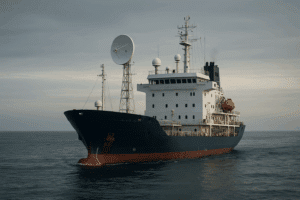Forecasting plays a vital role in supply chain logistics, shaping decision-making and strategy. Real-time insights boost efficiency, cut costs, and enhance customer satisfaction. For industries dependent on distant suppliers, a well-estimated ETA ensures on-schedule deliveries, limits disruptions, and strengthens planning for a competitive advantage.
Reliable ETAs are essential for precise projections in supply chain management. Besides scheduling, well-calculated ETAs enable businesses to anticipate obstacles, refine logistics, and maintain steady product availability.
Forecasting extends beyond delivery schedules—it optimizes supply chain operations. Well-informed projections help align resources and personnel, ensuring a seamless movement of goods.
Why forecasting is crucial for business success
No business can thrive on chance—it must anticipate customer trends, manage demand fluctuations, adjust production, and optimize inventory. In a competitive market, reliable forecasting helps companies make informed decisions rather than simply reacting to changes. This supports realistic sales targets, efficient budgeting, and strategic growth while keeping costs under control. Proactively addressing challenges also reduces operational risks.
Forecasting is essential for risk management, helping businesses:
• Maintain cash-flow stability
• Gauge demand through market analysis
• Optimize inventory management
The logistics industry faces risks like weather disruptions, fuel price fluctuations, geopolitical issues, and port congestion. Accurate ETAs help anticipate challenges, develop contingency plans, and enhance resilience, reducing costly delays and disruptions.
A driver of operational excellence
Accurate ETA estimates are crucial for supply chain efficiency, helping organizations reduce waiting times, costs, and inefficiencies. Maritime companies use machine learning to analyze real-time traffic patterns and other factors affecting ship arrivals. By leveraging historical data and continuous updates, these systems provide reliable ETA predictions, improving delivery schedules and decision-making.
For example, knowing the exact arrival time helps port crews allocate dock space efficiently, preventing bottlenecks and ensuring smooth cargo offloading. More accurate ETAs also enable shorter layovers, lower demurrage costs, and optimized fuel consumption, enhancing operational efficiency.
A pillar of customer satisfaction
Customer satisfaction in the maritime industry heavily depends on the reliability of delivery schedules, whether for large industrial shipments or smaller commercial consignments. When cargo owners receive precise arrival estimates, their trust in the company strengthens. Conversely, unreliable ETAs can result in setbacks, missed deadlines, and dissatisfied customers.
Furthermore, well-calculated ETA estimates enable proactive customer communication. Real-time data allows for immediate updates on unforeseen changes, ensuring customers remain informed about their shipments. This level of transparency fosters long-term loyalty and confidence in the service provider.
An effective way to cut costs
Accurate ETA predictions enhance operations, boost customer satisfaction, and reduce costs. Shipping companies and port operators can cut expenses related to fuel, labor, and demurrage by synchronizing operations around precise arrival times, minimizing wasted resources and delays.
For example, accurate ETAs help port operators schedule labor efficiently, ensuring stevedores and cranes are available when needed. Real-time traffic and weather updates further optimize shipping routes, reducing fuel consumption and travel time.
Machine learning models integrated into delivery management software continuously refine ETAs by adapting to traffic changes and port congestion. As these systems improve, companies can further lower costs tied to delays and disruptions.
The industry-specific benefits of accurate ETA
In today’s complex global supply chains, predicting arrivals and deliveries ensures that all aspects of the supply chain operate in unison. In maritime logistics, where weather, traffic conditions, and port congestion can cause unforeseen delays, accurate ETA estimates can make the difference between a smooth operation and costly disruptions.

For industrial and commercial companies
For industrial and commercial companies, accurate ETA predictions are essential for synchronizing production, optimizing inventory, and meeting customer demand. Late deliveries can cause production delays, stockouts, and revenue loss, making precise ETAs crucial for operational efficiency.
By integrating real-time data on traffic, weather, and port conditions, businesses can enhance ETA accuracy, anticipate delays, and adjust schedules proactively, reducing disruptions and improving supply chain reliability.
For shipping lines
For shipping lines, reliable ETA predictions are essential for route optimization and fuel efficiency. With pressure to cut costs while ensuring on-schedule deliveries, companies depend on machine learning models that analyze real-time traffic and marine conditions to refine routes and improve scheduling.
This foresight helps avoid bottlenecks by rerouting vessels before congestion builds. Well-calculated ETAs also strengthen risk management in challenging conditions by anticipating disruptions and adjusting schedules, minimizing setbacks, extra fuel consumption, and revenue loss.
Precise ETA estimates enhance fleet management, improving crew scheduling, fuel planning, and cargo handling. In an industry where minor setbacks can lead to major expenses, ETA reliability is key to maintaining operational efficiency.
For port operators and authorities
Port operators depend on reliable ETA forecasts to manage shipments efficiently and prevent bottlenecks. Knowing arrival schedules in advance allows for better allocation of berths, cranes, and labor, reducing congestion, inefficiencies, and downtime.
Real-time data enhances ETA precision by tracking vessel status and adjusting predictions based on traffic conditions and marine factors. This enables port authorities to optimize resource allocation and ensure a steady cargo flow.
Well-calculated ETAs also improve coordination with shipping companies, trucking firms, and logistics providers, keeping all stakeholders informed and ready. This helps prevent disruptions, streamline port operations, and enhance overall efficiency.
he role of technology in enhancing ETA accuracy
In today’s data-driven world, technology plays a crucial role in improving ETA reliability. AI-powered models in delivery management systems analyze real-time data to enhance supply chain efficiency.
These algorithms assess traffic conditions, port congestion, and vessel speeds to refine ETA predictions. As circumstances shift, continuous updates help companies make informed decisions and maintain smooth operations.
Advanced delivery management software integrates machine learning to provide real-time status updates, allowing for schedule adjustments and clear communication with customers.
A variety of ETA calculators serve different industries. Sinay’s specialized tool for shipping lines, port operators, and logistics providers leverages machine learning and real-time data, incorporating sea traffic and port congestion to ensure precise arrival forecasts. This enhances operational efficiency and strengthens customer satisfaction through better planning and communication.
FAQ - ETA for accurate forecasting
It enables businesses to plan operations efficiently, optimize logistics, and reduce uncertainties in delivery schedules.
By analyzing factors like traffic, port congestion, and vessel movement, real-time data helps refine arrival estimates.
Sectors like shipping, logistics, manufacturing, and retail rely on accurate ETAs to streamline operations and meet demand.
Inaccurate estimates can lead to missed deadlines, increased costs, inefficient resource allocation, and customer dissatisfaction.


